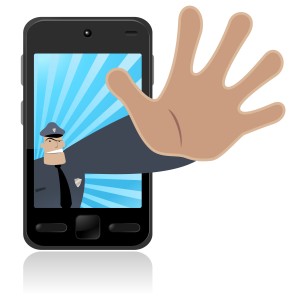Cell Phone Triage for Police Officers
 It’s the same story played all across America. It goes like this: Police Officer XYZ is dispatched to a residence where, as the First Responder, he discovers a crime scene. Officer XYZ notes a cell phone on the scene possibly belonging to the suspect or victim. Officer XYZ decides to search the phone for “investigative leads” and “evidence”. Then, accidentally, Officer XYZ DELETES the phone’s data or even worse, WIPES the phone’s data.
It’s the same story played all across America. It goes like this: Police Officer XYZ is dispatched to a residence where, as the First Responder, he discovers a crime scene. Officer XYZ notes a cell phone on the scene possibly belonging to the suspect or victim. Officer XYZ decides to search the phone for “investigative leads” and “evidence”. Then, accidentally, Officer XYZ DELETES the phone’s data or even worse, WIPES the phone’s data.
Now, if you were that officer, how would you tell your Chief/Sheriff about this mishap? How are you going to explain what you did to your prosecuting attorneys or better yet, the defense attorneys?
Cell phones are a blessing and a curse. They contain myriad amounts of information about someone. A cell phone reveals a person’s true character. It’s Digital DNA in a box! But, if the officer handling the phone is not careful, that blessed phone data could become a noose around his or her neck and possibly their career. Like any evidence, the cell phone and its contents must be handled correctly or the officer could lose that evidence.
The first responding officer is the initial evidence protector. That officer is responsible for the crime scene’s protection until other units, investigators and the forensics division get to the scene. Having been a police officer myself, I know what it is to arrive first on a hot scene and then have to handle everything until others arrive (and they never get there fast enough)!
Let’s imagine that you just responded to a crime scene. The suspect is gone but the victim is lying unresponsive on the floor. In the victim’s hand is a cell phone. What are you going to do? Let me give you some help.
In my book, Cellular Forensics for First Responders I share my unique “S.P.E.A.R. Digital Triage Method™”. I developed this method as a way to help police officers deal with cellular devices on a scene. In a case you may use one, some, or all of these steps. The goal is to give you a springboard to incorporate the cell phone and its data safely in to your case so that any evidence gained is not tainted.
The S.P.E.A.R. Digital Triage Method™
S = Survey the Scene: Look before you leap. Do you see a mobile phone on the scene? Then determine if you need to deal with it at this time (exigent circumstances) or if it can wait for the forensics professionals to arrive. Also, does your State or Agency allow you to examine a phone without a Warrant? Be careful of any 4th Amendment violations. Such violations can be very costly to both you and your agency.
P = Protect the Phone: you need to protect that mobile phone from outside contamination. That includes other officers on the scene that want to “monkey punch” and play with it. A phone can be contaminated or wiped digitally by outside signals. If the phone is off, leave it off!
E = Evaluate the Phone and Area: look for anything that is visible to the naked eye. Is there anything on the phone’s screen? Is the unit damaged? Password protected? Is the phone active or turned off? Is the phone worth the effort at this time or should you just let the forensics expert handle it?
A = Acquire the Phone: if you are in charge of the phone’s examination (and have been properly trained), use the forensic tools you have to acquire the data from the phone.
R = Report: your report of your handling, analysis and findings is very important in a case. Your report will go before you and allow the evidence to be presented or dismissed without you being present. Take your time.
So there you have it, an easy to follow guide to handling cell phone evidence at a crime scene. Use these simple steps and your career will thank you!
 Tom Slovenski is an international law enforcement instructor in Mobile Phone Forensics and owner of Cellular Forensics, LLC in South Carolina. Tom has over 25 years of investigative experience and is a former senior law enforcement detective. His highly acclaimed book, “Cellular Forensics for First Responders” has been widely accepted by law enforcement officers across the world and is available on Amazon.com. For more information, go to cellularforensics.com and cellphonetraining.info for class schedules, S.P.E.A.R Digital Triage Method™ Certification and other training information.
Tom Slovenski is an international law enforcement instructor in Mobile Phone Forensics and owner of Cellular Forensics, LLC in South Carolina. Tom has over 25 years of investigative experience and is a former senior law enforcement detective. His highly acclaimed book, “Cellular Forensics for First Responders” has been widely accepted by law enforcement officers across the world and is available on Amazon.com. For more information, go to cellularforensics.com and cellphonetraining.info for class schedules, S.P.E.A.R Digital Triage Method™ Certification and other training information.


